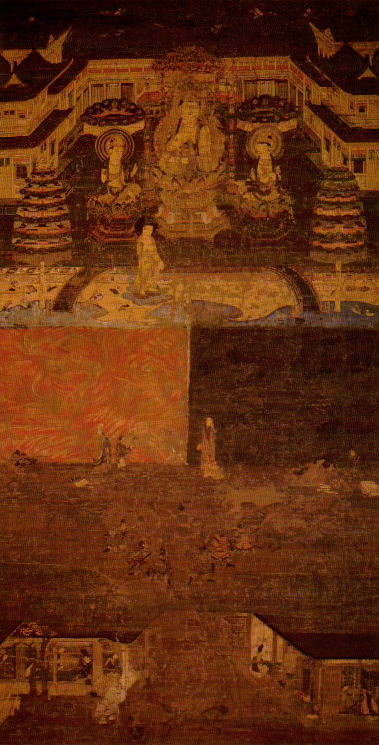
TWO RIVERS AND THE WHITE PATH
|

 |
(a)
The oldest painting of Two Rivers and the White Path, 13th century; preserved at the Komyoji, Nagaokakyo in the outskirts of Kyoto; painted in color on silk; 118.6x61.4cm.; an important cultural asset in Japan.
A glorious palace building is seen on the top. In the courtyard Amida and two bodhisattvas, Kannon and Seishi, are seated on the lotus-thrones. Two trees are in the foreground. Amida's transformed body is welcoming the aspirant on the western bank. Near the white path on the eastern bank is standing Shakyamuni Buddha. He is urging the traveler to take the path. Bandits and animals are pursuing the traveler. At the bottom are houses depicting the earthly life in Samsara.
¥gçgÒ¾ÝÒ¦gOkVÎîç¾¼ÝÒ¦gÉyóç
The meaning of the parable is as follows. 'The eastern bank' is the burning house of this Saha world. 'The western bank' is the Treasure Country of Utmost Bliss.
¾Q¯«b¼eÒ¦gO¶ZªZ¯ZoÜAlåç
'Bandits and vicious beasts calling with feigned friendship' refer to sentient beings' six sense-organs, six consciousnesses, six sense-bases, five aggregates, and four elements.
¾³lóçòÒ¦gí«Fsl^Pm¯ç
'The open plain where there is no one to be found' refers to always mixing with evil friends without having a chance to meet a true good teacher.
¾ ÎñÍÒ¦gO¶æä@ áÑ@Îç
'The two rivers of water and fire' describes sentient beings' greed and lust which are like water and their anger and hatred which are like fire.
¾Ô¹lÜ¡Ò¦gO¶æÃáÑÏY\¶´òè¶SçTRæÃáÑ̦g@ ÎPS÷Ìg@¹
'The white path in the middle, four or five inches wide' shows that a pure aspiration for birth arises from within sentient beings' evil passions of greed and anger. Since greed and anger are intense, they are compared to the water and fire. Since a good mind is faint, it is compared to a white path.
gí¼¹Ò¦g¤SíN\õPSçÎíĹҦgáÑVS\Ä÷¿V@àç
Further, 'waves always splash the path' describes the greed which constantly arises and defiles one's good mind. 'Flames always burn the path' shows that anger and hatred burn the Dharma-treasure of virtue.
¾ls¹ã¼ü¼Ò¦gôsƼü¼ûç¾Ý·lº©q¹¼¼iÒ¦gßÞßÅãls©RL³@Âq¦gV@ºç
'This man at once takes the path westward' shows that he, at once, proceeds westward by leaving behind various practices. 'Hearing a voice from the eastern bank urging him to proceed, he immediately takes the path to the west' shows that even though Shakyamuni has already passsed away and people can no longer see him, his teaching still exists and can be followed; the teaching is compared to a voice.
¾½sêªñªQ¯«ôÒ¦gÊðÊs«©lÏà©ðRfy©¢ßÞ¸ç
'As he takes a step or two, bandits call him to return' shows that people of different understandings, different practices and wrong views confuse him with their false views, saying, "You will commit evil karma and fall back from the Path."
¾¼ÝãLl«Ò¦gíÉèÓç
'There is a man on the western bank calling to him' refers to the purport of Amida's Vow.
¾{äk¼ÝPF©ìÒ¦gO¶v¾¶D ËôÀ|©Z³RðEÂÖßÞwü¼ûåSíÉßSµ«
"In no time he reaches the western bank and rejoices at seeing his good friend" shows that the sentient beings who have long been sinking in the state of birth-and-death, transmigrating from the eternal past and being deluded and bound by their own karma, from which they cannot set themselves free, are now urged by Shakyamuni to proceed to the west - they are also summoned by Amida's Compassion.
¡Mñ¸VÓsÚ ÎñÍOO³âæÞèÍV¹Ì½ß㾶Þ^§©cì½Éç
Faithfully following the wishes of the two sages, they take the path of Vow-Power with constant mindfulness while unafraid of the two rivers of water and fire; after their death, they will be born in his land, where they will see the Buddha with boundless joy.
^mñÍæ g¾¹lÜ¡Ò¹ÒV¾ÎçÒ¦¥IðÛæVÆñüVòÆç
Truly we realize that, in the parable of the two rivers, 'the White Path four or five inches wide' has the following meaning: 'white' in 'the white path' is contrasted to 'black'; 'white' refers to the white act selected and adopted [in the Vow], that is, the Pure Karmic Act endowed to us for our Going forth.
Ò¦¥³¾ÏYVÆñælVVGPç
'Black' refers to the black [evil] actions of our ignorance and evil passions and also to the miscellaneous good deeds done by the followers of the Two Vehicles, namely humans and gods.
¹V¾ÎH¹Ò¥¥{èêÀV¼¹åʸϳãVå¹çHÒ¥¥ñæOæPsV¬Hç
'Path' is contrasted to 'lane'; the Path refers to the straight path of truth of the Primal Vow - the supreme Great Path leading to the Great and Complete Nirvana. 'Lanes' refer to small passages of the teachings of the Two Vehicles and Three Vehicles and of myriad good deeds and various practices.
¾lÜ¡ÒgO¶låÜAç@¾\¶´òèSÒl¾à^Sç{èÍñüåMSCÌsÂjógV@àç
'Four or five inches wide' refers to the four elements and the five aggregates that constitute sentient beings. 'A pure aspiration for birth arises' means attainment of the Diamond-hard True Faith; since it is the ocean of Great Faith endowed by the Primal Vow-Power, it is indestructible; hence, it is compared to diamond.
Index